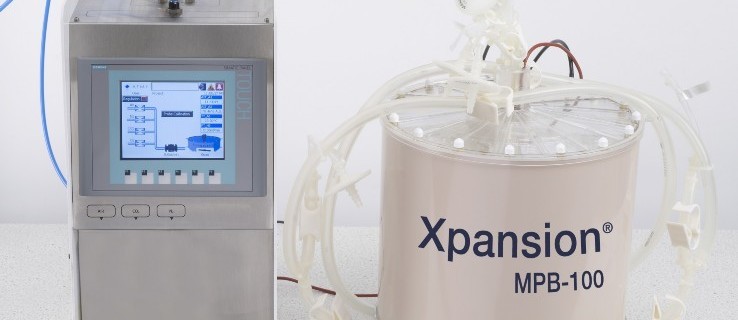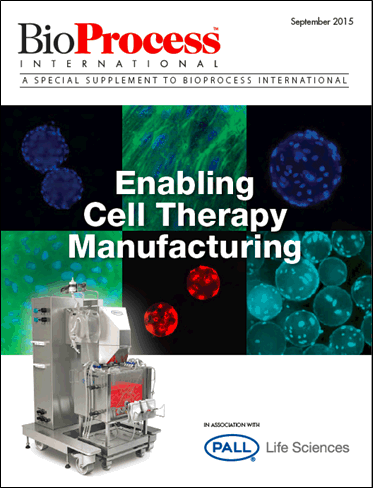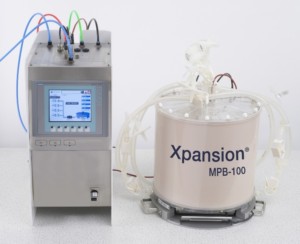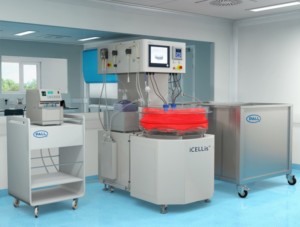
Part II – A Look at the State of Cell Therapy – Current Manufacturing Options and Opportunities for Further Advancements
Introduction
Yesterday we published Part I in this Cell Therapy series covering “Enabling Cell Therapy,” an informative supplement published by BioProcess International in conjunction with Pall Life Sciences. The publication contains twelve articles all covering various aspects of the Cell Therapy industry and related manufacturing. In this series, I have provided highlights from the articles. For full details, please see the original supplement.
Manufacturing in Practice
Autologous vs. Allogeneic
 Autologous therapies are examples of personalized medicine. They use a patient’s own cells as the starting point and are manufactured as a single lot per patient. Autologous scale up is frequently referred to as “scaling out” because manufacturing requires the production of many small lots of individual products manufactured at the same time.
Autologous therapies are examples of personalized medicine. They use a patient’s own cells as the starting point and are manufactured as a single lot per patient. Autologous scale up is frequently referred to as “scaling out” because manufacturing requires the production of many small lots of individual products manufactured at the same time.
Allogeneic therapies on the other hand are manufactured in large lots from unrelated donor tissue. Allogeneic therapies are considered “off the shelf” in that it is one product used to treat many patients. These therapies require scale up and can often adapt techniques used to scale up protein drugs or vaccines.
Autologous Manufacturing
The supplement article, “Moving from Laboratory to Commercial Production with a Single-Use Multiplate Bioreactor,” describes the opportunity that ATMI, since acquired by Pall, had to work with a biotech company that was developing an autologous Cell Therapy to protect patients’ hearts during myocardial injury using the patients bone marrow stem cells. The company was moving into Phase III clinical trials and needed an efficient way to scale up to meet product demand for 3,000 patients. They were looking to stay in 2D culture as they wanted to minimize any product changes that might occur in scale up. They required a cost effective, GMP process in a closed system.
The Xpansion bioreactor was a perfect fit because it used 2D adherent culture but had higher cell density in a smaller footprint.  In the design of the product, the gas phase layer was removed between the plates, thus reducing the amount of space needed between plates. The gas exchange function was then moved to a central column where media can circulate instead of circulating between the plates. This change enabled a 200 plate bioreactor and resulted in the same growing capacity as 20 stacks, but with a significantly smaller footprint. The unique design also incorporates circular plates that contain 16 radial channels to circulate media, thus minimizing shear stress. The Xpansion also permits more control of culture parameters. In this case, the use of the Xpansion bioreactor reduced the necessary facility footprint and was able to cut costs in half, in addition to reducing annual operating expenses by 40%.
In the design of the product, the gas phase layer was removed between the plates, thus reducing the amount of space needed between plates. The gas exchange function was then moved to a central column where media can circulate instead of circulating between the plates. This change enabled a 200 plate bioreactor and resulted in the same growing capacity as 20 stacks, but with a significantly smaller footprint. The unique design also incorporates circular plates that contain 16 radial channels to circulate media, thus minimizing shear stress. The Xpansion also permits more control of culture parameters. In this case, the use of the Xpansion bioreactor reduced the necessary facility footprint and was able to cut costs in half, in addition to reducing annual operating expenses by 40%.
For more information on autologous manufacturing or the Xpansion bioreactor, please see the following article from the Enabling Cell Therapy supplement:
- Moving from Laboratory to Commercial Production with a Single-Use Multiplate Bioreactor
Allogeneic Manufacturing
In the supplement article, “Designing the Most Cost-Effective Manufacturing Strategy for Allogeneic Cell-Based Therapies,” Suzanne Farid, Professor, bioprocess systems engineering at University College London, presented their work on an advanced bioprocess model to help inform manufacturing decisions for allogeneic therapies.
To begin, Ms. Farid’s group identified several problems related to cell therapies that did not exist in protein drug manufacturing. These included that for Cell Therapy there was limited technology for large scale manufacturing, the adherent nature of cells used in cell therapies meant limited expansion potential and that single use technology was considered critical because of sterility concerns, which further reduced available equipment options. Her team began investigating manufacturing methods for cell therapies that were currently in the clinic or were commercial and found that manufacturing relied heavily on T-flask and 10 layer trays despite the fact that these methods were deemed insufficient to meet dose and product demand estimates.
This research led the team to create a decisional tool to help Cell Therapy companies identify the most cost-effective technologies available for manufacturing allogeneic cell therapies and which best suited their needs. As part of the tool’s function they captured key costs and key inputs. Key costs include materials, labor, quality control and fixed overhead. Key inputs include cell type, demand, technology options and a database of process facility and cost parameters. Once analyzed the tool delivered key outputs including identification of optimal technologies for upstream and downstream processing and a cost of goods structure.
The team then conducted a case study on cell expansion and tested their decisional tool. They demonstrated that the tool recognized that for low dose scenarios, planar technologies are feasible. However, at higher doses of 108 and 109 it is preferable to switch from 2D to 3D suspension culture. They also determined that for very high dose and demand scenarios i.e. 10 trillion cells per lot, no existing technology can meet demands. This is an area where technologies will need to be improved or new technologies created.
According to their research, high lot sizes upstream also create challenges for volume reduction and downstream processing. Current approaches include bench top centrifuges, but high lot sizes would render this method impossible, as you would need an estimated 25,000 machines. As a result the industry must move toward more scalable technologies including Tangential Flow Filtration (TFF) and single use fluidized bed centrifugation.
They also found that when using planar technologies the cost of goods is 50/50 upstream and downstream, however in microcarrier suspension culture cost of goods is dominated by downstream, thus highlighting the work that still needs to be done in large volume downstream processing.
When considering a move to microcarriers it is important to note that they found that microcarriers can offer greater than 50% cost of goods savings at commercial scale which would outweigh the development costs involved in switching from 2D to 3D culture.
For more information on Allogeneic Cell Therapy Manufacturing, please see the following article from the Enabling Cell Therapy supplement or the associated webinar:
- Designing the Most Cost-Effective Manufacturing Strategy for Allogeneic Cell-Based Therapies
- Webinar: Designing the Most Cost-Effective Manufacturing Strategy for Allogeneic Cell-Based Therapies
Large Volume Manufacturing – Enabling Technologies in Depth
Microcarrier Optimization
Microcarriers come in a broad range of options, for example Pall SoloHill microcarriers offers eight types for use in Cell Therapy manufacturing. Options include the type of material (plastic, collagen, glass, etc.) and the type of surface (rigid, porous, microporous). Other choices include surface coatings or charged moieties to affect surface chemistry. With all these options available it is important to select the right mix of microcarrier, bioreactor vessel, and cell culture media to meet the needs of your cells and your manufacturing.
An key procedure in successful microcarrier culture is optimization. Key steps in the optimization process include:
- Fully characterize cell type in flatware culture to set parameters that will guide initial conditions in microcarrier culture. This also sets a baseline from which to measure any changes that may occur in cell function during transition to microcarrier culture.
- Use small scale formats including multiwell bioreactors or small scale spinners to optimize parameters involving cell seeding, microcarrier concentration and media formulation.
- Optimize cell harvest starting with ideal conditions for enzymatic removal in flatware or evaluate other removal options including microcarrier coatings and surface options.
- Further optimize process in 2L-5L bioreactors to more closely represent the physical conditions and process controls in full scale manufacturing.
For more information on manufacturing using microcarriers and microcarrier optimization, please see the following articles from the Enabling Cell Therapy supplement:
- Expansion and Characterization of Mesenchymal Stem Cells on Pall SoloHill® Microcarriers
- Strategies for Microcarrier Culture Optimization
Importance of Single-use in Cell Therapy
As mentioned earlier, single-use manufacturing is considered critical in Cell Therapy manufacturing in order to provide: cost-effective manufacturing, minimal possibility of contamination, a closed system and flexibility in manufacturing. Single-use bioreactors can be paired with microcarriers to create a fully closed system and a cost-effective approach for adherent cell expansion.
For more information on manufacturing using single-use technologies in Cell Therapy manufacturing, please see the following article from the Enabling Cell Therapy supplement:
- Single-Use Bioreactors and Microcarriers: Scalable Technology for Cell-Based Therapies
Opportunities for other Cell-based Therapies
There are also other promising cell based-therapies in the clinical pipeline including Gene Therapy and CAR T-cell immunotherapy treatments for cancer. Both of these innovative approaches to treatment rely on cells as part of the treatment  and face similar manufacturing challenges in bringing a product to commercialization. As these treatments are newer and have had less experience in clinical trials and larger scale manufacturing, they will benefit from the manufacturing lessons learned with stem cell therapies.
and face similar manufacturing challenges in bringing a product to commercialization. As these treatments are newer and have had less experience in clinical trials and larger scale manufacturing, they will benefit from the manufacturing lessons learned with stem cell therapies.
For more information on manufacturing other cell-based therapies, please see the following articles from the Enabling Cell Therapy supplement:
- T-Cell Suspension Culture in a 24-Well Microbioreactor: High-Throughput Screening of Operating Conditions
- Production of Viral Vectors Using the iCELLis® Fixed-Bed Bioreactor System: Beyond Mesenchymal Stem Cells — Gene-Modified Cell Therapy, Gene Therapy, and Exosomes